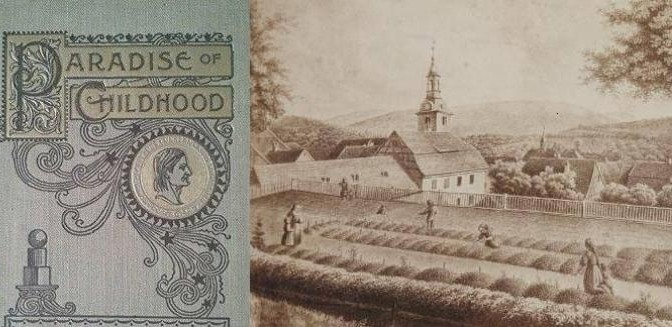This scarce antiquarian book is available as a facsimile reprint of the original, because this work is culturally important.
The 1896 Quarter century edition of The paradise of childhood: A practical guide to kindergartners can be read online or found a library.
A digitised version of Paradise of Childhood by Edward Wiebe, Edited by Milton Bradley London: George Phillip & Son Ltd., 1896 is available online as part of the Froebel Digital Collection.
The first Kindergarten in Bad blankenburg included a garden for children to plant seeds and care for plants. Friedrich Froebel introduced the concept of gardens for children, where they could participate in all aspects of growing, harvesting, and preparing nutritious, seasonal produce. As educational tools, these gardens provide real world applications of core mathematical concepts. The Edible Schoolyard educates children about the connections between food, health, and the environment through activities which are fully integrated into the curriculum.
The word “paradise” entered English from the French paradis, inherited from the Latin paradisus, from Greek parádeisos (παράδεισος), and ultimately from Avestan, the language of Zoroastrian scripture, as pairi.daêza-. The literal meaning is “walled enclosure”, from pairi- “around” + -diz “to create (a wall)”. It came to indicate walled estates, especially the carefully tended royal parks of Cyrus the Great described by Xenophon in Anabasis. The Hebrew word pardes does not appear before the post-Exilic period (post-538 BCE) in each case meaning “park” or “garden”, including an “orchard” or a “fruit garden”. Later in Judaism “paradise” came to be associated with the Garden of Eden and prophesies of restoration of Eden. The Abrahamic faiths associate paradise with the Garden of Eden, the perfect state of the world prior to the fall from grace, and the perfect state that will be restored in the World to Come.
Paradise is a place in which existence is positive, harmonious and eternal. In paradise there is peace, prosperity, and happiness. Paradise is a place of contentment, but not of luxury and idleness.
Charlemagne sought to revive arts and learning with this list of plants to be grown on his royal estates: lily, roses, fenugreek, costmary, sage, rue, southernwood, cucumbers, pumpkins, gourds, kidney-bean, cumin, rosemary, caraway, chick-pea, squill, gladiolus, tarragon, anise, colocynth, chicory, ammi, sesili, lettuces, spider’s foot, rocket salad, garden cress, burdock, penny-royal, hemlock, parsley, celery, lovage, juniper, dill, sweet fennel, endive, dittany, white mustard, summer savory, water mint, garden mint, wild mint, tansy, catnip, centaury, garden poppy, beets, hazelwort, marshmallows, mallows, carrots, parsnip, orach, spinach, kohlrabi, cabbages, onions, chives, leeks, radishes, shallots, cibols, garlic, madder, teazles, broad beans, peas, coriander, chervil, capers, clary. And the gardener shall have house-leeks growing on his house. As for trees, it is our wish that they shall have various kinds of apple, pear, plum, sorb, medlar, chestnut and peach; quince, hazel, almond, mulberry, laurel, pine, fig, nut and cherry trees of various kinds. The names of apples are: gozmaringa, geroldinga, crevedella, spirauca; there are sweet ones, bitter ones, those that keep well, those that are to be eaten straightaway, and early ones. Of pears they are to have three or four kinds, those that keep well, sweet ones, cooking pears and the late-ripening ones.
